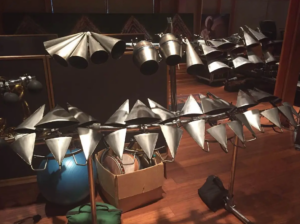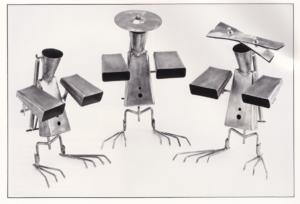SHOW #4 Dallas, TX – May 26th – COMET BELLS
SHOW #4 Dallas, TX – COMET BELLS

Pete Engelhart has been crafting bells, bangers and clangers with distinct personalities since the mid-’70s. You’ve heard them in the music of the Grateful Dead and Led Zeppelin and in the soundtracks of ‘Wall-E’ and ‘Tenet.’
Finding Pete Engelhart’s workshop feels a little like stumbling into that Charlie and the Chocolate Factory scene where Gene Wilder ushers the golden ticket gang into Willie Wonka’s Chocolate Room. But instead of a bucolic candyland, Engelhart dwells in a fantastical realm that he’s populated with a metallic menagerie of snails, blossom bells, garrapatas, crashers, agogos, and reco recos.

To find this land of pure imagination, you wander down a threadbare strip of Second Street in West Berkeley, pull open a 12-foot corrugated steel gateway and head east through a 100-yard canyon of car doors, motor blocks, and wrecked, half-dissected vehicles. A stand-alone square building festooned with decades of expertly welded creations, the workshop is where he makes a glorious profusion of instruments designed to define or augment a groove with an array of metallic pitches.
Something of a legend among fellow musicians, particularly percussionists who prize his creations, Engelhart has been envisioning, building and painstakingly perfecting all manner of bells, bangers and clangers at his Second Street laboratory since the mid-1990s. “It’s funny, people think I’m in Los Angeles or New York but I’ve been here in Berkeley since I started making instruments,” said Engelhart, whose contributions to Berkeley’s cultural scene stretch back half a century.
Despite some reservations, he acceded to entreaties by body-music maestro Keith Terry, percussion star John Santos, and vocalist Cecilia Engelhart, the second of his three daughters, to participate in a concert featuring dear friends playing music that he composed or helped inspire. Some of the other artists include bassists David Belove and Don Falzone, banjoist Evie Ladin, percussionist Kenneth Nash, and trombonist Jeff Cressman (who along with Berkeley drummer Josh Jones worked with Engelhart in the 1980s when he had to deliver a huge order of ribbon crashers).
Engelhart likes to say that he started making instruments because it was something he could do without formal study. Completely self taught, he came to the practice at mid-life after he inherited an old welding machine from the family ranch, which was nestled in the shadow of Mt. Diablo. Deeply enamored with Brazilian music, particularly percussion ensembles, he set out to make a cowbell-like implement for a close friend, prolific recording artist Kenneth Nash. The process was long and laborious and the end result wasn’t particularly elegant. But it sounded good, and Engelhart’s musician friends took note.
“The first ones were very primitive, and then Airto and Flora [Purim] came to town,” Engelhart said, referring to the Brazilian couple who’d attained near pop star status in the mid-1970s through projects with Miles Davis, Chick Corea’s Return to Forever, and their own albums for Berkeley’s Milestone Records. “That was a spark! I actually dug underneath my house and made shop and worked there.”
At that point Engelhart was mostly giving the instruments away, but when a request for a set of tuned bells came in from Los Angeles drum great Shelly Manne, he made his first sale. Gregarious, wide-eyed and given to stream-of-consciousness soliloquies, he loves to tell stories about musician friends, but he’s also allergic to name-dropping for self-promotion. Led Zeppelin drummer John Bonham incorporated several of his instruments in his kit, but Engelhart never met him and the band’s moniker escapes him.
After spending a little time with Engelhart, it’s hard not to think about who would play him in a movie. There’s his world’s-most-interesting-man biography, which includes race cars and rodeos, a three-week trip to Brazil that turned into a two-year São Paulo sojourn, a formative stint as a pianist on the 1950s L.A. jazz scene, and friendships with many of the most consequent musicians of the 20th century. But what makes him so compelling as a character is his gift for unguarded revelation that invites a reciprocal response. There’s a touch of the mad scientist about him, but filtered through a soulful scrim. Imagine Harry Dean Stanton playing Christopher Lloyd’s Doc Brown in Back to the Future.
Hollywood is where you’ve undoubtedly encountered Engelhart’s handiwork, as the scores for numerous hit films and series have conspicuously featured his instruments, such as The Mandalorian, Mulan, Tenet, Wall-E, Dr. Sleep, Finding Nemo, American Beauty, Robots, Turning Red, and many others. He hasn’t often encountered his own instruments on screen, but there was that time he was watching a 1999 news segment about the massive Seattle WTO protests and “there were people coming down the street banging my blossom bells,” he recalled with a grin. “I had sold a bunch of them to John’s Music Center up in Seattle.”
A short list of the musicians who’ve played his creations includes Brazilian masters Egberto Gismonti and Cyro Baptista, the Grateful Dead’s Mickey Hart, studio wizards Emil Richards and Jamey Haddad, and jazz players Jerry Granelli and Scott Amendola. He makes instruments as a visiting artist for the cymbal company Sabian and supplies several drum stores with his wares, including L.A.’s Professional Drum Shop. His instruments are also available via the website Pete Engelhart Metal Percussion. He still goes into his workshop almost every day and seems to find deep joy in the physical process.

“He’s an overly creative person,” said Cecilia Engelhart. “He built the house we grew up in. Everything that happened in the house he built or fixed. He’d paint murals on the walls, big circles and triangles with solid colors. He has this eye for shapes, in particular. He was always doing something like that, and once he started the instruments he channeled all his creativity into that.”
It wasn’t until his then-wife Locha Engelhart started representing him that his practice became a self-sustaining business. Possessing a gift for organization — at one point she managed avant-garde jazz legend Cecil Taylor — she lined up contracts and handled promotion, which meant the sale of smaller instruments subsidized his ambitious, kinetic, sculptural pieces for the likes of the Grateful Dead and Keith Terry. The family house on Cherry Street became a bustling musicians’ hang. Engelhart at work. Courtesy: Pete Engelhart Metal Percussion
“When Airto and Flora and Hermeto Pascoal were recording at Fantasy with Orrin Keepnews, they were living in our house,” Cecilia recalled. “Our friends would come over and freak out. Our house was an after-gig hang. McCoy Tyner and Palle Danielsson would be there. People would hang out until 5 in the morning. It was just normal to me.”
Several of the musicians on Sunday’s program, such as pianist Benny Green, trumpeter/tenor saxophonist Peck Allmond, and multi-instrumentalist Peter Apfelbaum, came into the Engelhart family orbit through Berkeley High friendships with Cecilia and her sisters Selena and Claudia. In the mid 1970s the Engelhart house became a multi-generational cultural center where Brazilian masters and veteran jazz cats rubbed shoulders with a bevy of prodigious Berkeley High musicians, including Steven Bernstein, Jessica and Tony Jones and Craig Handy.
BUSD’s innovative jazz program launched by Dr. Herb Wong gets a lot of deserved credit for the remarkable profusion of talent that emerged from Berkeley High in the 1970s, but that first generation benefited greatly from the household’s open-armed spirit. “We’d start at Berigan’s Record Shop on Claremont and, after they’d close, the whole group would go over and listen to records at Pete’s,” Apfelbaum said. “Sometimes we’d get treated to big Mexican style dinner — Cecilia’s mom, Locha, is Mexican — and we’d hang with Pete’s friends. A lot of good connections were formed at that house.”
Apfelbaum first made a national mark with his large ensemble Hieroglyphics, which occasionally rehearsed at the Cherry Street abode when the family was out of town. Engelhart helped fund the band’s first recording, and decades later is still close with Apfelbaum, who’ll be playing several of his pieces Sunday “that run the gamut between the hard bop Pete would have been playing in the ‘50s to stuff that’s very open and lyrical, with a logic all of their own,” he said. “They remind me of someone like Carla Bley, open and unclassifiable. These other things that are very haunting and lyrical. We’ll mostly do those as quintet with Peck and myself on sax, Benny on piano, Don Falzone on bass and Scott Amendola on drums.”
Keith Terry doesn’t remember exactly how he first met Engelhart, but their relationship blossomed in the 1980s and his instruments figured prominently in Terry’s solo career. “I had these ideas for instruments and he’d go wild with them,” said Terry, who’s played a central role in conceptualizing and creating the International Body Music movement. Enamored with Engelhart’s large, sculptural instruments, like the towering piece Josephina that he built for Airto, Terry worked with Engelhart to perfect Maxine, who became something of a percussion alter ego.

“I had this idea for how it could walk and we started there,” Terry said. “We played around with springs and gave it motion. It’s an instrument as tall as I am or taller that I could dance with, a beautiful instrument with 25 bells, springs and ridges. The tuning is masterful. Pete has a great ear for matching pitches. She’s really quite beautiful and moves in this birdlike way. I’m playing her and backing up and she follows me. That’s Maxine.”
It’s interesting to note that Engelhart isn’t a percussionist himself. He doesn’t build instruments to suit his own musical needs. He’s a jazz pianist who, though given to self-deprecation, was good enough to work steadily in Los Angeles when the scene brimmed with numerous excellent players (“I had a good feel,” he said). After years in L.A. he moved back up to the East Bay with a band that included future bass star Barre Phillips, who pioneered solo bass recitals and recordings. They landed a regular gig at the short-lived Berkeley club Tsubo (which was immortalized by guitarist Wes Montgomery’s 1962 live album Full House). Located at Telegraph and Russell, it was in the same building as the jazz station KJAZ and later housed the folk music venue The Jaberwock. He credits Phillips with opening his mind musically, and during a brief glorious run they attracted some of the music’s leading improvisers.
“Dewey Redman would come and play with us,” he said. “We’d say, ‘That guy is going to go somewhere!’ The Montgomery brothers were always around. The Bay Area cats came in. The night with Ornette Coleman was amazing. I started playing ‘Giant Steps.’ He shouted to me ‘no changes,’” a wider harmonic concept that left a deep impression.
Engelhart has no end of jaw-dropping stories, but what’s most surprising is a tale that hasn’t been told. It’s true that he has no inclination for self-promotion, but how has he worked in Berkeley for so long without wider recognition? Unschooled and utterly independent, the man is a quintessential outside artist, yet his art has never been featured in a solo show (though the San Francisco Art Institute once presented his work with two other sculptors).
“Everybody who sees his work says there should have been huge exhibitions,” Cecilia said. “It’s shocking that no one has been able to put him forward. There are Facebook pages dedicated to him. All these Europeans are obsessed with this stuff. He’s a cult figure. They’re not just art pieces. They’re played. They’re instruments.”
Source: https://www.berkeleyside.org/2022/08/05/pete-engelhart-metal-percussion-west-berkeley
